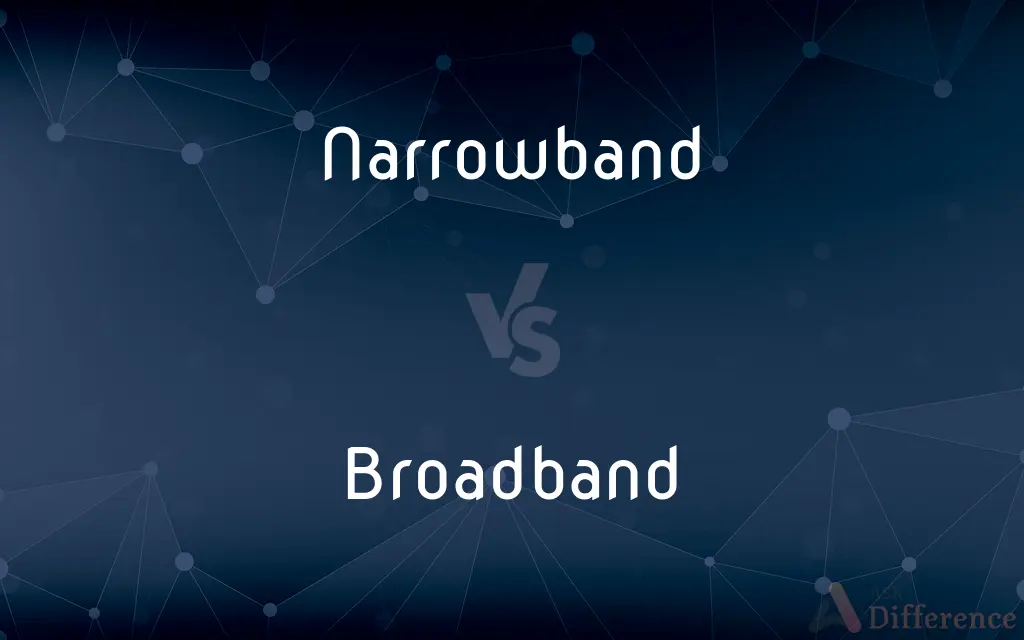Narrowband vs. Broadband — What's the Difference?
By Maham Liaqat & Urooj Arif — Updated on March 8, 2024
Narrowband focuses on transmitting a single type of data stream, while broadband supports multiple data types simultaneously.

Difference Between Narrowband and Broadband
Table of Contents
ADVERTISEMENT
Key Differences
Narrowband communications transmit data over a narrow band of frequencies, typically supporting a single type of data stream, such as voice or low-rate data. This makes it efficient for specific applications but limits the bandwidth and data transfer rate. Broadband, on the other hand, utilizes a wider band of frequencies, allowing for the transmission of multiple data streams simultaneously. This results in higher data transfer rates and the capacity to support a variety of services like internet, television, and voice communications all at once.
While narrowband is characterized by its limited frequency range, resulting in lower data rates suitable for applications like voice calls and text messaging, broadband offers a much larger frequency range. This wider range supports higher data rates, making it ideal for data-intensive applications such as video streaming and high-speed internet access.
Narrowband's limited bandwidth makes it well-suited for applications requiring minimal data transfer, like IoT devices and certain industrial applications where efficiency and long-range communication are key. Broadband, however, is tailored for residential and commercial applications demanding high-speed data transmission, such as video conferencing, online gaming, and large file downloads.
The technological infrastructure required for narrowband is typically less complex and less expensive to deploy, making it a cost-effective solution for specific applications and in areas where broadband infrastructure is not feasible. Broadband, with its need for more sophisticated infrastructure like fiber optic cables, demands a higher investment but offers greater versatility and speed.
Comparison Chart
Bandwidth
Limited
Wide
ADVERTISEMENT
Data Transfer Rate
Lower
Higher
Applications
Voice, text, IoT
Internet, video, high-speed data
Infrastructure Complexity
Less complex
More complex
Cost
Generally lower
Generally higher
Compare with Definitions
Narrowband
Characterized by lower data transfer rates.
Narrowband connections struggle with high-quality video streaming.
Broadband
Broadband covers a wide band of frequencies, supporting high data rates.
Broadband connections enable seamless video conferencing.
Narrowband
It's suited for specific, low-data applications.
Narrowband IoT devices are efficient for remote monitoring.
Broadband
Requires more sophisticated infrastructure.
Deploying broadband often involves laying fiber optic cables.
Narrowband
Narrowband refers to communication over a narrow band of frequencies.
Many rural areas still rely on narrowband connections for internet access.
Broadband
Ideal for data-intensive applications.
Online gaming and streaming are best experienced over broadband.
Narrowband
Often used in voice communication systems.
Traditional landline phones operate over narrowband frequencies.
Broadband
Supports multiple data types simultaneously.
Broadband allows for internet, TV, and voice services over one connection.
Narrowband
Requires less complex infrastructure.
Setting up a narrowband network is less costly than broadband.
Broadband
Generally offers higher data transfer rates.
Broadband connections can achieve speeds of several hundred Mbps.
Narrowband
In radio communications, a narrowband channel is a channel in which the bandwidth of the message does not significantly exceed the channel's coherence bandwidth. In the study of wired channels, narrowband implies that the channel under consideration is sufficiently narrow that its frequency response can be considered flat.
Broadband
In telecommunications, broadband is wide bandwidth data transmission which transports multiple signals and traffic types. The medium can be coaxial cable, optical fiber, radio, twisted pair or satellite.
Narrowband
Describing communication systems with a smaller bandwidth than wideband.
Broadband
Of or relating to high-bandwidth data transmission.
Broadband
Of or relating to data transmission that uses multiple channels so that multiple pieces of data can be transmitted simultaneously.
Broadband
Any of several technologies that allow rapid transmission of data, as by using multiple channels simultaneously.
Broadband
(telecommunications) Of, pertaining to, or carrying a wide band of electromagnetic frequencies
Broadband
(telecommunications) A wide band of electromagnetic frequencies
Broadband
(Internet) An internet connection provisioned over an existing service using alternate signal frequencies such as ADSL or cable modem.
Broadband
Of or relating to or being a communications network in which the bandwidth can be divided and shared by multiple simultaneous signals (as for voice or data or video)
Broadband
Responding to or operating at a wide band of frequencies;
A broadband antenna
Common Curiosities
What is broadband?
Broadband involves communication over a wide band of frequencies, allowing for high-speed data transmission and multiple services simultaneously.
What are typical applications of narrowband?
Narrowband is used for voice communications, text messaging, and IoT devices requiring low data rates.
Can narrowband support video streaming?
Due to its lower data rates, narrowband is generally not suitable for high-quality video streaming.
What is narrowband?
Narrowband refers to communication over a narrow band of frequencies, suitable for low-data applications like voice calls.
Why is narrowband still used?
Narrowband remains useful for applications where low data rates are sufficient and cost or infrastructure constraints exist.
How do narrowband and broadband differ in terms of bandwidth?
Narrowband has limited bandwidth, while broadband offers a wide bandwidth for higher data rates.
What makes broadband suitable for residential use?
Broadband's high data rates support internet, video streaming, and online gaming, making it ideal for home use.
Is broadband more expensive than narrowband?
Broadband typically requires more complex infrastructure, making it generally more expensive than narrowband.
Can broadband support voice services?
Yes, broadband can support voice services along with other data-intensive applications.
Can narrowband and broadband coexist in the same network?
While they serve different purposes, narrowband and broadband technologies can be integrated within a broader telecommunications network.
Are there areas where only narrowband is available?
Yes, in some remote or rural areas, narrowband may be the only feasible communication option due to infrastructure limitations.
How does narrowband benefit IoT devices?
Narrowband's efficiency and long-range capabilities make it suitable for low-power, low-data-rate IoT applications.
What future developments are expected in broadband technology?
Ongoing advancements in broadband aim to increase speeds and reduce latency, enhancing overall connectivity and enabling new applications.
How does the infrastructure for narrowband and broadband compare?
Narrowband requires less complex infrastructure than broadband, which often involves advanced technologies like fiber optics.
What are the speed differences between narrowband and broadband?
Broadband offers significantly higher speeds compared to the lower rates of narrowband.
Share Your Discovery

Previous Comparison
Diagnosis vs. Treatment
Next Comparison
Server vs. DatabaseAuthor Spotlight
Written by
Maham LiaqatCo-written by
Urooj ArifUrooj is a skilled content writer at Ask Difference, known for her exceptional ability to simplify complex topics into engaging and informative content. With a passion for research and a flair for clear, concise writing, she consistently delivers articles that resonate with our diverse audience.















































